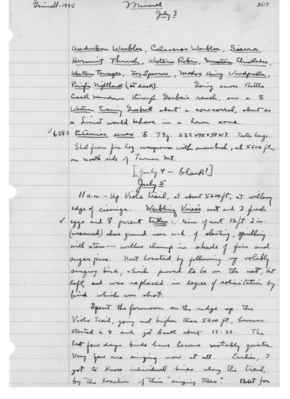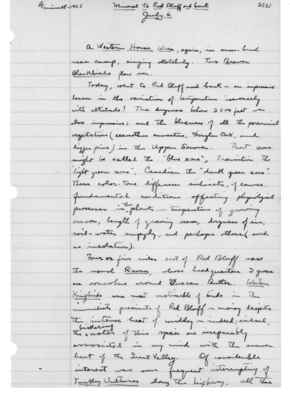Pages That Mention 1925
1925: Joseph Grinnell's field notes
S2 Page 66
Collector: Grinnell - 1925 Location: Mineral Date: July 3 Page Number: 2519
Audubon Warbler, Calaveras Warbler, Sierra Hermit Thrush, Western Robin, Mountain Chickadee, Western Tanager, Fox Sparrow, Modoc Hairy Woodpecker, Pacific Nighthawk (at dusk). Going across Battle Creek Meadows through Gerber's (?) ranch, saw a [male symbol] Western Evening Grosbeak about a cow-corral, about as a Linnet would behave in a lower zone.
6283 Eutamias senex [male symbol] 79g. 232x98x34x17. Testes large. Shot from fir log overgrown with snowbush, at 5500 ft., on north side of Turner Mt.
July 4 - blank!]
July 5 11 a.m. - Up Viola trail, at about 5600 ft., at willowy edge of cienaga. Warbling Vireo's nest and 3 fresh eggs and female parent taken: rim of nest 12 ft. 2 in. (measured) above ground near end of slanting, spindling will [sic] stem - willow clump in shade of firs and sugar pine. Nest located by following up volubly singing bird, which proved to be on the nest, but left, and was replaced in degree of solicitation by bird which was shot.
Spent the forenoon on the ridge up the Viola Trail, going not higher than 5600 ft., however. Started a [sic] 8 and got back about 12:30. The last few days birds have become notably quieter. Very few are singing now at all. Earlier, I got to know individual birds along the trail, by the location of their "singing trees." But for
S2 Page 67
Collector: Grinnell - 1925 Location: Mineral Date: July 5 Page Number: 2520
the most part, there [sic] are silent now. Tanagers, Hermit Thrushes and Warbling Vireos are still in song; but nearly all warblers, flycatchers and finches are quiet. Indeed, I heard the song of but one Hermit Warbler, where I heard dozens on June 22. Heard but 2 or 3 Audubon Warblers this morning. Heard a Grouse "boonting" in a big fir, so persistently that I circled the tree without disturbing him. I couldn't see him. Flushed a hen from the dusty trail, but failed to find any young.
6284 Hammond Flycatcher [female symbol] ad. 9.7g. Shot from fir twig about 30 ft. from ground in woods on ridge at 5500 ft. Note that molt has begun in innermost primaries, and that lower mandible is not especially dusky; indeed, it is quite pale flesh-color.
6285 Warbling Vireo [female symbol] 13.7 g. Contained fully formed yolk, a little "white" but not shell: would have laid 4th egg tomorrow. With nest and set 1/3 (incomplete, as above. ^Shot in willow. See p. 2519.
6286 Western Tanager [male symbol] ad. testes [testes illustration]. 28.6 g. Shot on ground beneath young firs, whither it had just; 5000 ft.
6287 Mariposa Fox Sparrow [female symbol] ad. 30.7g. Shot in thicket of arctostaphylos patula, in large tract of chaparral at about 5600 ft.
The young in the Wright Flycatcher's nest at camp, which hatched on June 17 (see p. 2491), left the nest voluntarily this forenoon sometime. Time in nest, 18 days ±.
6288 Bufo boreas found under board in our tent.
S2 Page 68
Collector: Grinnell - 1925 Location: Mineral to Red Bluff and back Date: July 6 Page Number: 2521
A western House Wren, again, in snow-brush near camp, singing sketchily. Two Brewer Blackbirds flew over.
Today, went to Red Bluff and back - an impressive lesson in the variation of temperature inversely with altitude! The dryness below 3500 feet was also impressive; and the blueness of all the perennial vegetation (ceanothus cuneatus, Douglas Oak, and digger pine) in the Upper Sonoran. That zone might be called the "blue zone", Transition the "light green zone", Canadian the "dark green zone". These color-tone differences indicate, of course, fundamental conditions affecting physiological processes in ^the plants - temperature of growing season, length of growing season, dryness of air, soil-water supply, and perhaps others (such as insolation).
Four or five miles east of Red Bluff saw the usual Raven, whose headquarters I guess are somewhere around Tuscan Buttes. Western Kingbirds were most noticeable of birds in the immediate precincts of Red Bluff - noisy despite the intense heat of midday - indeed; indeed, the ^bickering notes of this species are inseparable, associated in my mind with the summer heat of the Great Valley. Of considerable interest was our frequent interrupting of Turkey Vultures along the highway, all the
S2 Page 69
Collector: Grinnell - 1925 Location: Red Bluff to ]]Mineral]] Date: July 6 Page Number: 2522
way from the edge of the yellow pines (3300 ft., about) to within the miles of Red Bluff. There is a great deal of "speeding" on this road, stretches of which are straight and finely surfaced. As a result, numbers of Jack Rabbits and Douglas Ground Squirrels are run down; and these "remains" form a quite dependable food source for the Turkey Vultures, which evidently patrol the highway regularly for these victims of the auto. The mammal bodies are, of course, as a rule conspicuous on the roadways, much more so than in the chaparral or on the lava "plains" elsewhere. This is a new manner of draft on the mammalian population; a carefully taken census over a given, average stretch of road-way, would be significant in this connection. There may have been compensation already, however; for example, last winter, I was told by one of the road men that he and others kept steel traps going, for coyotes, ^bob-cats, and foxes, the pelts of which are so valuable. I suppose that means a let-up on the draft of carnivores upon those vegetarians.
Our trip down and back was unfavorable to observing birds along the way. Mostly, when we were stopping, nothing was to be heard; the quiet season has arrived. The hearing of call-notes of Slender-billed Nuthatches
S2 Page 70
Collector: Grinnell - 1925 Location: Mineral Date: July 6 Page Number: 2523
and Western Bluebirds from the very sparse blue oaks on the hot, glaring "plains" above Dale's, where we changed a tire, was notable. Aren't these birds really of "austral" predilection (origin), rather than "boreal" (like the chickadees and creepers)?
July 7 9 a.m. - At camp. The brood of young Chipping Sparrow's near camp left their nest yesterday (see p. 2482); I located two of them nearby, in little yellow pines, this morning; they are bob-tailed, with wisps of natal down still adhering to the contour feather-tips on their heads. Time, in this case, from beginning of incubation to departure of young, approximately 21 days. The parents of this brood are already starting another nest, I think; were getting nest material, ^male singing now and then, and copulated 4 times in one minute, tho immediately afterward were greatly concerned over my too close approach to a young one!
Found another Chipping Sparrow's nest, with 4 half-feathered young which would probably left [sic] for good, had I disturbed them. Rim of nest only 780 mm. above the ground. Nest located in thick^-foliaged slanting spray of ceanothus cordulatus, near edge of clump of same, well sheltered and shaded by dense leafage directly above. There were many young yellow pines round about, but these had been passed up for the low ceanothus in this instance. Also saw full-grown and independent Chipping Sparrows elsewhere, in bush.




